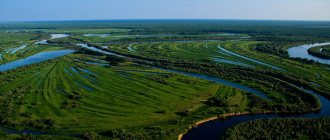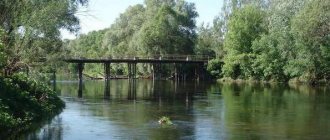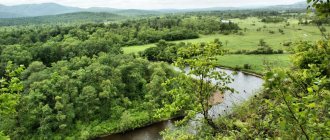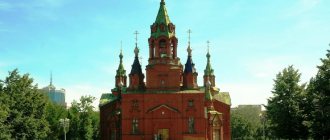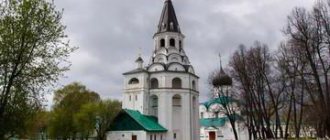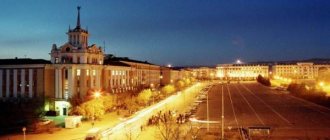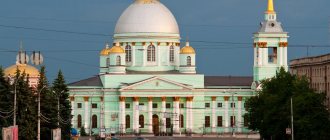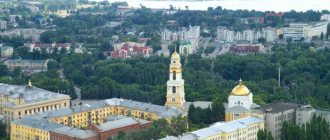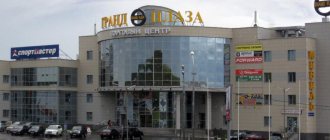Geography
The Tyumen region is located in the center of the Eurasian continent and is part of the West Siberian Plain. The region borders the Khanty-Mansi Autonomous Okrug (KhMAO), as well as the Omsk, Kurgan, Sverdlovsk and Tomsk regions. In the south it has a federal border with Kazakhstan. The largest river in the region is the Irtysh (3.7 thousand km), it is a source of drinking water and a shipping canal. The Tyumen region occupies an area of 160.1 thousand square meters. km. In addition, the region is located at the intersection of transport routes that pass through Tyumen from north to south and from west to east. Federal highways P351, P254, P402 are located here. The P404 highway goes to Surgut and Khanty-Mansiysk and is the only land route that connects the region with the Khanty-Mansiysk Autonomous Okrug. The Moscow-Vladivostok road passes through the region, which is part of the emerging Berlin-Beijing transnational corridor.
Facts of the ancient history of the region
The settlement of the territory of the modern Tyumen region began in the Upper (Late) Paleolithic about 43 thousand years ago. This fact is confirmed by an amazing find near the village of Baygara - the supracalcaneal (talus) bone of a hominid. Its size is approximately 4.5 by 5 cm, and it belonged to an adult individual aged 20-50 years, who lived in these places 43 thousand years ago. It is assumed that the hominid belonged to the genus Homo sapiens.
It should be noted that the area of the Tyumen region is quite large, and archaeologists have plenty of room to roam around in search of confirmation of the early settlement of these lands. Thus, on the shores of Lake Andreevskoye and Tura, the first traces of human habitation were discovered (cemeteries and remains of settlements). They belong to the Sargat culture, which existed in the 7th-6th centuries. BC e. In the first millennium, the settlement of nomads began: the Ugrians and Samoyed tribes, who were forced out of the south by Turkic-speaking peoples. Mixing with the indigenous tribes, they formed new nationalities, in particular the Mansi and Khanty, the Selkups, and the Nenets.
In the 13th-16th centuries, the capital of the Tyumen Khanate of Kereits and Tatars was located on the banks of the Tyumenka. It was a vassal of the medieval eastern state of the Golden Horde. After the division of the latter into separate khanates, the first unification was formed in Siberia - the Principality of Great Tyumen. It was replaced by the Siberian Khanate in 1420 with its capital at Kashlyk.
Administrative division
The Tyumen region is a complex subject. The history of the formation of the region begins with the Tobolsk province - the region from which the Russians began to develop Siberia. Here are the oldest Siberian cities - Tyumen and Tobolsk. During the years of Soviet power, the territory of the Tyumen region underwent several administrative and territorial reorganizations. It has existed within its modern borders since 1944, when the Tyumen region was formed with its center in Tyumen. It included the Khanty-Mansi and Yamalo-Nenets Autonomous Okrugs, which in 1993 received the status of equal subjects of the Russian Federation. There are five cities, 21 districts and 1.2 thousand rural settlements in the region.
Tyumen region
The Tyumen region (without autonomous okrugs) is located within the West Siberian Plain, occupies the south of the region and makes up about 11% of its entire territory.
Territory - 161.8 thousand km 2
It borders with the Sverdlovsk, Kurgan, Omsk regions, the Khanty-Mansi Autonomous Okrug and the Republic of Kazakhstan.
Population -1314.5 thousand people
Population density - 8.2 people. per 1 km2
Administrative center - Tyumen (570.9 thousand people)
The Tyumen region is a complex subject of the Russian Federation: in addition to the south of the Tyumen region, it geographically includes the Khanty-Mansiysk and Yamalo-Nenets autonomous okrugs. They are not its administrative units and remain full-fledged subjects of the Federation.
The Tyumen region is today one of the most stable regions of the Russian Federation. The growth of the gross regional product in 2007 amounted to more than 10 percent. Moreover, the growth of this indicator is occurring at a higher rate than the average for the Russian Federation.
The region's economy is characterized by a diversified structure. There is large industrial potential, developed transport infrastructure, productive agriculture, and a wide range of various social services.
All major modes of transport are developed in the region. Oil and gas pipelines, railways and highways, waterways pass through here, and air transport is developed. The region is crossed by a section of the Trans-Siberian Railway passing through Tyumen, Yalutorovsk, Zavodoukovsk, Ishim. The railway connection connects the Trans-Siberian Railway with the main centers of oil and gas production in the autonomous regions.
There are passenger and cargo air connections with many cities of Russia and foreign countries. River transport is used to communicate with many areas of the region during the navigation period. Through the Tyumen river port, cargo is delivered to the river ports of industrial centers located on river highways.
The social policy of the Regional Government is currently defined as one of the main priorities. There is a positive trend in the birth rate in the region, natural population growth is increasing every year, and the mortality rate is stabilizing. During January - October 2007, the natural population increase in the Tyumen region was 935 people, the migration increase was 4827 people. This situation allows us to predict a gradual improvement in the demographic situation in the region.
The number of unemployed people in the region is decreasing every year; as of November 1, 2007, it amounted to 8.5 thousand people. An active employment policy pursued by the state employment service to employ the unemployed and retrain the unemployed population is aimed at reducing unemployment in the region. Today the unemployment rate is less than 1.3%.
The average monthly salary of one employee in the Tyumen region is 414.7 euros. According to this indicator, the Tyumen region occupies one of the leading positions in the country.
The subsoil of the Tyumen region contains various minerals: oil, peat, quartz sands, brick and expanded clay, sapropels, limestones, fresh and mineral waters, etc.
The region has large reserves of peat, the industrial reserves (495 deposits) of which are estimated at 37 billion m3, and there are 5 deposits in development. In some peat deposits, large deposits of vivianite (iron phosphate) have been identified (about 20% of world reserves), the use of which can satisfy agricultural needs for phosphate fertilizers.
There are deposits.
The south of the region is rich in fresh and mineral water reserves. Groundwater contains significant reserves of iodine and bromine. The largest iodine-bromine deposits are Cherkashinskoye and Tobolsk, whose iodine water reserves are of industrial importance. The Tyumen region has enormous potential and opportunities for the construction of sanatoriums and boarding houses.
The region is characterized by the presence of a large number of rivers and lakes. The longest rivers: Irtysh, Tobol, Ishim, Tavda, Tura, the largest lakes: Bolshoi Uvat, Chernoe. The reservoirs are home to about 30 species of fish, 20 of which are of commercial importance.
Proximity to economically developed regions of the European part of the country, primarily to the Urals, provision with a variety of natural resources, high industrial potential, political stability are the main features that determine the investment attractiveness of the region. Internationally, economic development is influenced by the region’s proximity to Kazakhstan and proximity to the markets of Central Asia and China.
In the south of the region, the electric power industry has developed significantly, fully meeting the needs of the region and transmitting energy to other regions. Tyumen CHPP-1 and CHPP-2 are among the largest electricity producers in Europe operating on associated gas. Germany's largest energy concern E.ON and the Russian corporation STS have formed a joint venture in Tyumen - CJSC E.ON-CTC Energy. The new company plans to develop generation construction projects in the Tyumen region with an approximate capacity of 3000 MW.
The oil refining industry has been developed, providing the country's petrochemical complex with light hydrocarbon raw materials. In 2006, the Antipinsky oil refinery began operating. Its capacity is 500 thousand tons. By 2009, it is planned to increase capacity to 3,000 thousand tons of oil per year.
The chemical and petrochemical industries produce butadiene, synthetic resins, plastics, polyethylene pipes, and polymer films. At the initiative of OJSC Sibur Holding, the world's largest petrochemical complex for the production of olefins and polymers is being created in the region. At the first stage, propane dehydrogenation and polypropylene production plants with a capacity of 500 thousand tons per year will be built on the basis of Tobolsk-Neftekhim LLC. The investment volume is 1.7 billion euros.
Tyumen products are in high demand
machine-building plants: oil field, drilling,
geological exploration, oil refining equipment, tractor trailers, woodworking machines, concrete mixers. The companies Schlumberger and Bentec Drilling & Oilfield Systems are implementing projects for the production of oil and gas equipment in the Tyumen region. Bentec Drilling and Oilfield Systems will create production of drilling rigs and components in Tyumen in 2007-2008. The investment amount is 18 million euros. Schlumberger has already built three factories and a training center in the region. Investments in this project to date have amounted to more than 90 million euros. The German company intends to create production of products for the oil and gas sector.
The building materials industry produces prefabricated reinforced concrete structures and products, parts for large-panel housing construction, bricks, wall blocks, environmentally friendly insulating materials, ceramic tiles and facing tiles. Turetskaya is organizing the production of formwork for monolithic housing construction in the region in the amount of 10 million euros. plans to organize the production of dry mixtures, investments in the project will also amount to 10 million euros.
The forestry and woodworking industries play an important role in the development of the region. Significant forest reserves are concentrated in the region. The total forest stock in the region is about 920 million cubic meters. The region produces a wide range of furniture, as well as thermal insulation, finishing and other materials and wood products.
The Tyumen region has favorable conditions for the development of agriculture. The area of farmland is 3352.2 thousand km2, the area of arable land is 1632.5 thousand km2. Agricultural land makes up 21% of the land fund in the region. The presence of soils with high fertility potential and fairly moderate climatic conditions make it possible to grow grain, potatoes, vegetables, roughage and succulent feed. Cattle, pigs, goats, horses, and poultry are raised here.
(Netherlands) decided to create a production of feed premixes in the Tyumen region.
At the end of 2007, two consulting companies RASTAM-Osenka (Russia, Tyumen) and IAK AGRAR Consulting GmbH (Germany, Leipzig) developed a “Strategy for the investment development of the food industry, agriculture and fishery of the Tyumen region until 2021.” It defines the goals of investment development of the mentioned areas, the required volumes of investment resources in them, and highlights the advantages of the Tyumen region in these areas among competing regions.
Along with this, the Tyumen region is one of the regions of Russia with the highest housing construction activity. At the end of 2007, 896 thousand square meters were put into operation in the region. meters of total living space. According to this indicator, the Tyumen region has confidently occupied a leading position among the regions of the Ural Federal District in recent years.
Currently, there are 11 higher educational institutions operating in the south of the Tyumen region, the number of full-time students is 49,105, and 37,493 part-time students.
The research complex of the Tyumen region is one of the youngest and unique in terms of scale and pace of development in the Russian Federation. In the region, 37 organizations are engaged in research activities. They annually carry out about two thousand scientific research and development, most of which are oil and gas developments. Every year, specialists in the region receive over 200 patents for inventions.
The Tyumen region is included in the state program for the creation of technology parks in the Russian Federation in the field of high technologies. The creation of an oil and gas innovation center in Tyumen in the short term will make it possible to intensify the processes of implementation and commercialization of developed advanced technologies for the oil and gas sector of the economy, and will create prestigious jobs for a large number of highly qualified researchers and engineering and technical specialists. The technology park should become the basis for the development of innovative activities in the region, a connecting link between universities, scientific laboratories and industrial production.
A new promising direction of the regional economy is tourism. Economic potential, unique historical and cultural monuments, the presence of hotel service organizations, and an advantageous geographical location contribute to the active development of this area. In order to develop tourism potential, the leading tour operator in Germany, Olympia Reisen, has developed a Tourism Development Strategy in the Tyumen Region. An important part of creating cultural tourism projects is the phased formation of “locomotive” tourism and transport projects and new tourist routes in the Tyumen region.
In order to more effectively develop the regional economy, the Government of the Tyumen region has also developed a strategy
economic development of the region until 2021, development strategy for the light, forestry and woodworking industries.
Strategies for investment development of the machine-building complex, the construction industry, transport and logistics, and the real estate market are at the development stage.
In the future, it is planned to develop strategies for investment development of the oil refining and petrochemical industries, energy, housing and communal services, services, and shipbuilding.
In accordance with the developed Strategies, the main directions for developing the regional economy and attracting investments have been determined:
• Oil and gas complex cluster
• Electricity Cluster
• Forestry and woodworking cluster
• Light industry cluster
• Service and trade cluster
• Agriculture and food industry cluster
• Cluster of construction and building materials industry
• Transport and logistics cluster
Currently, in almost every one of the industries listed above, large investment projects are being implemented or planned for implementation. In the oil and gas complex, it is proposed to build an oil refinery with a capacity of 1 million tons of oil, organize the production of mineral fertilizers, create a bitumen production with a capacity of 70 thousand tons, tire products, paint and varnish products, as well as other types of products made of polyethylene and polypropylene, production of oil and gas equipment, .
The Finnish consulting company Jaakko Puri Consulting has developed a strategy for the development of the forestry and woodworking industry in the Tyumen region. It identifies some priority projects for the development of the industry for the production of chipboard, MDF, dry softwood lumber, OSB, as well as a logging enterprise.
In the light industry cluster, projects have been identified for the production of woolen fabrics, finished textiles, children's clothing, work and special clothing, and functional clothing for medical services.
Currently, 7 new hotels are being built in the region, which will be built in the very center of Tyumen, with the involvement of international operators (Radisson (SAS Residor), Mariott, Domina Hotels & Resorts). METRO, Lenta, Perekrestok, Mosmart, and Monetka hypermarkets were built. Negotiations are underway with the companies Carrefour, Ramstore, Auchan, Castorama, IKEA. Investors may be offered projects in this area.
In the field of agriculture and food industry, projects have been identified for the production and processing of vegetables, processing of wild plants, meat and fish, the creation of confectionery production and other food products, as well as the organization of the production of biodiesel fuel by processing rapeseed.
Construction is actively developing in the region. This entails a huge demand for building materials. The region has reserves of raw materials necessary for the production of various types of building materials. In the construction and building materials industry cluster, there are projects to organize the production of bricks, sheet glass, cement, thermal insulation materials, roofing materials, finishing materials, expanded clay, wall panels, plasterboard, wallpaper, as well as other materials used in construction:
Recently, due to the entry of large international companies into the region’s market, the role of product delivery and storage has increased significantly. The following projects are proposed in the transport and logistics cluster:
1. Construction of a network of logistics complexes with an area of up to 250 thousand m2 to meet the needs of the region, with the involvement of large operators. One of the proposed projects is the construction of a multifunctional class “A” logistics complex with a total area of 70 thousand square meters. meters in Tyumen, initiated by the Partner holding. The volume of investments is about 46 million euros;
2. Development of shipping and shipbuilding on the basis of existing enterprises in the region;
3. Development of the Roshchino International Airport. A development plan is currently being developed together with Hochtief;
4. Construction of the Eastern Bypass ring road around the city of Tyumen with a length of 12.5 km.
In the Tyumen region, such companies as Lukoil, TNK-BP, Gazprom, Halliburton (USA), OMV (Austria), Salym Petroleum Development (Netherlands-UK) and many others have already begun their work. In 2006, the international recruitment agency Kelly Services and the insurance company Ergo began operating in the region. In 2007, a branch of Raiffeisenbank (Austria), a representative office of the Moscow
international bank, a branch of the Bank Societe Generale East (France) will open in the near future.
The companies Schlumberger, Halliburton, KSA Deutag, DeLaval are creating training centers in Tyumen to train specialists according to international standards. Similar ones, RAO Russian Railways, are already operating, and a branch of the British International School has opened.
In recent years, the Tyumen region has seen a steady increase in investment in fixed capital. In 2005, 56.3 billion rubles were invested in the development of the economy and social sphere of the Tyumen region (without autonomous okrugs), in 2006 - 70.7 billion rubles, and in 2007 - 89.5 billion rubles.
In the Tyumen region, the foundations of the legal, infrastructure and information base have been created to attract investment, and a guarantee mechanism has been developed to protect the rights of investors. Current regulatory documents
regulate investment activities in the region, determine the conditions and forms of state support. In 2003, regional law No. 159 “On state support of investment activities in the Tyumen region” was adopted. In accordance with this law, the following forms of support are provided in the region for holders of investment projects:
1. tax benefits provided in the manner established by federal and regional legislation;
2. budget loans;
3. investment tax credits;
4. subsidies and subventions;
5. public investment from the regional budget;
6. providing assistance in the procedure for the provision of land plots and other real estate objects that are in regional ownership;
7. guarantees.
In order to stimulate the investment process, the Regional Duma approved amendments to the Law of the Tyumen Region “On the provision of tax benefits for 2008 to certain categories of taxpayers” dated November 7, 2007 No. 39.
For clearer work on realizing investment potential and creating the most favorable conditions for investors in the Tyumen region, in January 2007, in accordance with the Decree of the Governor of the Tyumen Region, the Council for Economic Development of the Tyumen Region was created under the Governor of the Tyumen Region. The structure was created to consider and study investment proposals and projects, subsequent coordination of the activities of executive authorities of the Tyumen region related to the provision of comprehensive assistance and support for the implementation of investment projects, and the development of recommendations to local governments on the implementation of a unified investment policy.
The government of the Tyumen region, pursuing a policy aimed at supporting investment activities, improving its methods and forms of implementation, defines the main goal in this direction as ensuring sustainable growth of investments in the real sector of the economy, creating economic, legal and organizational conditions for investment activities that ensure sustainable economic dynamics development of the region and solving socio-economic problems.
All detailed information about the investment potential of the Tyumen region can be found on the Internet resource “Investment passport of the Tyumen region” . This project is aimed at reducing information barriers to entering the regional market, increasing the investment attractiveness of the region and intensifying the process of attracting investments. The Internet version of the investment passport of the Tyumen region contains the most up-to-date information about the investment climate and conditions for conducting investment activities in the region.
The development and implementation of a unified investment policy, as well as the implementation of the foreign economic policy of the Tyumen region, the formation of mechanisms for state support for investment activities in the region is entrusted to the Department of Investment Policy and State Support of Entrepreneurship of the Tyumen Region .
Contact phone : 8 (3452) 296-317, 296-492 E - mail : [email protected]
All information about the Tyumen region can be found on the official website of the Regional Government at https://www.admtyumen.ru
The Internet resource “Investment Passport of the Tyumen Region” can be found at http :// www . investintyumen . ru
Symbolism
The modern coat of arms and flag of the Tyumen region were approved on October 24, 2008 by the Tyumen Regional Duma. In the center of the coat of arms is a tricolor shield, on which there are three azure crowns with patterns characteristic of the indigenous peoples of the North, and a golden disk divided into two parts. The upper semicircle of the disk has the appearance of a shining sun, and the lower one is an azure disk with seven black pillars, symbolizing oil and gas reserves in the region. The shield is topped with a gold imperial crown. To the left and right there are shield holders - black sables, whose muzzle, throat and chest are painted gold. At the bottom of the coat of arms, on two golden arrows, there is the motto: “Siberia will grow.”
The flag consists of three horizontal stripes of different colors: white, blue and green. The shaft has a red triangle, the top of which is directed towards the center. On the blue stripe there are three crowns with the same patterns of the northern peoples.
Climate of the central and southern part of the region
The central and southern part of the Tyumen region is subject to a temperate climate, which is formed in the Northern Hemisphere. It is characterized by frequent and significant changes in atmospheric pressure, air temperature, and changes in wind direction. All this is the result of intense cyclone activity. A temperate climate has four distinct seasons: winter and summer (main), autumn and spring (intermediate). In winter, permanent snow cover is established. The climate can have varying degrees of severity from moderate to sharply continental. Thus, the duration of the period with air temperatures below 0°C is 130 days a year in the capital of the region. The area of the south of the Tyumen region is approximately 1/3 of the entire territory.
Population
According to preliminary data as of June 1, 2021, 1.5 million people live in the region. The number of Tyumen residents is growing: natural population growth in January - June 2021 was 1.7 thousand people, migration growth over the same period was 6.9 thousand people. The population is urbanized—more than 66% of Tyumen residents live in cities. The total amount of cash income of the population for January - November 2017, according to Tyumenstat, increased by 5.2% (compared to the same period in 2021) and amounted to 456.2 billion rubles. On average, the accrued salary of a resident of the region is 41.5 thousand rubles. per month (for the first half of 2021), which is 9.9% more than the same period in 2021. As of July 1, 2021, 3.9 thousand unemployed people were registered in the region, the unemployment rate of the economically active population is 0.55%.
Last year, Tyumen took first place in the ranking of Russian cities in terms of the quality of life of people, which was compiled by the Financial University under the Government of the Russian Federation. The assessment used the opinions of the population on issues of medical care, the quality of roads, the level of culture and education, the state of housing, an assessment of the work of city authorities and migration sentiments. According to the study results, the city received the maximum 100 points.
How to get to Tyumen?
You can get there in several ways, depending on your finances and comfort:
- arrive by plane;
- by buses from Yekaterinburg, Omsk and other administrative centers;
- on minibuses (we are talking about the suburbs).
Of course, the plane is the fastest option. Two hours - and you are on the other side of the country! A ticket to Tyumen will cost up to 7,000 thousand rubles. The railway method is more budget-friendly: it takes longer, but is much cheaper. Buses run from the bus station to the city.
You can take advantage of private car/minibus transportation that will take you directly to the center.
As many car drivers notice, there is a convenient transport interchange, which allows you to:
- get to the city center from any corner in a few minutes;
- cross without any problems.
If you are outside the country, it is best to choose a plane. You can get to Tyumen by rail from Kazakhstan without any hassle. If we are talking about Krasnoyarsk, Nalchik, Moscow or St. Petersburg, then a plane ticket is your main assistant!
Attention! Due to fires and thick smog, traffic may be limited!
Despite the fact that the environment has suffered significantly, outside of Tyumen you can have a good time fishing or simply relaxing in the Siberian depths. But solely at your discretion and depending on the time of year.
As local residents note, it is better to fish in the cold seasons - in the summer you can’t have much rest, especially during fires.
Economy
In 2021, the Tyumen region topped the National Rating of the investment climate in the constituent entities of the Russian Federation. In a similar ranking for 2016, the region took fifth place, in 2021 - sixth. The rating evaluates the efforts of regional authorities to create favorable conditions for doing business and identifies the best business practices.
According to Rosstat, in 2021 the increase in investment in fixed assets in the region amounted to 19.9% - this is the eighth place in the country. Among the subjects of the Ural Federal District, the Tyumen region took first place in terms of investment growth, seriously ahead of other Ural leaders - Khanty-Mansi Autonomous Okrug (13.9% increase) and the Chelyabinsk region (1% increase). This growth is largely ensured by the active implementation of the project for the construction in Tobolsk of the country's largest petrochemical complex, ZapSibNeftekhim, owned by SIBUR.
The largest volume of investments is directed to the manufacturing sector. According to data for January - March 2021, 79.6% of the total investments of organizations were invested in production. Investment in the manufacturing industry amounted to 56.9%, an increase of 6.3% compared to 2021. For the first quarter of 2021, the total investment amounted to 66.8 billion rubles, which is 26.7% more than the same period last year.
Industry
At the end of the first half of 2021, the industrial production index in the Tyumen region amounted to 108.3% compared to the corresponding period in 2021. The growth was largely provided by manufacturing industries (109.2%). The development of the manufacturing sector was seriously influenced by the Antipinsky Oil Refinery. At the end of 2021, manufacturing enterprises shipped products worth 667.8 billion rubles.
Metallurgy also showed a high index - 136%, enterprises producing rubber and plastic products - 126.2%. The production of pipes and fittings from polymer materials increased 1.5 times.
Over the past 10 years, 49 large production facilities have been opened in the Tyumen region, including nine with the involvement of foreign capital. In the region, a plant for deep processing of wheat and the production of lysine "Aminosib", "Tyumen Dairy Farms" (with the participation of Danone), the plant "Tyumen Agro", a glass container production enterprise "Steklotekh", a fish complex "Era-98", a complex for deep wood processing "Tyumen Timber Industry Complex". Schlumberger, Schwank, DynaEnergetics GmbH, MC-Bauchemie, Baker Hughes, Knauf Insulation have localized their production in the region. In total, 490 projects are being implemented in the Tyumen region with an investment volume of more than 1.6 trillion rubles, on the basis of which 14 thousand jobs have already been created.
Industrial parks
To accommodate new production facilities, four industrial parks operate in the region: “Borovsky” for small and medium-sized processing industries, “Bogandinsky” for large manufacturing enterprises, the industrial and logistics park “DSK-500” and the agro-industrial park “Ishimsky”.
“Borovsky”, with a total area of 27.9 hectares, was 93% full in August 2021: it housed 11 of their 12 possible residents. The largest park in the region, Bogandinsky, is located on 267.9 hectares and currently has four residents. In August 2021, the Russian government included these two parks in the federal list of projects for the creation of industrial parks, which will allow the region to reimburse the costs of creating park infrastructure from the federal budget.
International relationships
The foreign trade turnover of the Tyumen region, taking into account mutual trade with the countries of the Eurasian Economic Union (EAEU), for the six months of 2021 amounted to $1.9 billion. This amount, according to the Ural Customs Administration, accounts for $1.2 billion in exports and $711 million in imports. In first place in terms of export volume are supplies of oil and petroleum products, mainly diesel fuel and liquefied hydrocarbon gases - 66% of exports ($828 million). In second place are products of the chemical industry, primarily organic chemical compounds and polypropylene - 30.2% ($367.5 million). The largest part of exports consists of products from the Antipinsky Oil Refinery and SIBUR enterprises. In addition, the region supplies wood products, equipment, food products and agricultural raw materials.
The largest volume of Tyumen products is purchased by the Netherlands (30.8% of total exports), France, Sweden, Great Britain, Belgium, Poland, the Republic of Belarus, Finland, Germany, Kazakhstan, China and Turkey. The largest importing countries are Germany, USA, China and Italy. The Tyumen region mainly imports machinery, equipment and vehicles (75.5% of imports).
Minerals
The Tyumen region has hydrocarbon reserves that are noticeable on a global scale. It is in its depths that the bulk of the country's gas and oil is concentrated. The total volume of geological exploration drilling exceeded 45 million m3. Oil is produced mainly in the Ob region, and gas in the northern regions. The process is associated with the rapid development of the region. The most famous and richest hydrocarbon deposits are Fedorovskoye, Mamontovskoye, Priobskoye, Samotlorskoye, and gas fields - Yamburgskoye, Urengoyskoye, Medvezhye. Peat, quartz sand, sapropels, limestone, precious stones, and metal ore (copper, chromite, lead) are mined.
